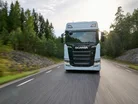Scania: Pioneering Circularity with Gearbox Remanufacturing

In the push towards sustainability, many businesses are exploring circular economy models to reduce emissions, build resilient supply chains and drive growth.
Circularity plays a vital role in addressing Scope 3 categories as defined by the Greenhouse Gas Protocol.
In Purchased Goods and Services (Category 1), circular practices reduce reliance on new raw materials by utilising recycled components, thereby lowering emissions. For Waste Generated in Operations (Category 5), strategies like improved product design and waste reduction initiatives minimise waste.
Meanwhile, in End-of-Life Treatment of Sold Products (Category 12), remanufacturing extends product lifespans through repair and recycling. Use of Sold Products (Category 11) benefits from energy-efficient designs and product-as-a-service models. Lastly, Upstream and Downstream Transportation (Categories 4 and 9) sees emissions reduced by optimising logistics and localising remanufacturing efforts.
Scania is at the forefront of this shift, incorporating reused components into its assembly line in Sweden.
This innovation marks a global first for heavy vehicle manufacturers, a significant step towards circular manufacturing.
Scania's remanufactured gearbox project stands out for its efficiency. By reusing parts, the company cut material use by 50% and slashed carbon emissions by 45%, all without compromising quality.
The remanufactured gearboxes undergo the same rigorous testing as those made from new parts and Scania reports they meet all the usual standards.
Fredrik Nilzén, Head of Sustainability at Scania, highlights the achievement: "What an achievement by the project and everyone involved.
"This remanufactured gearbox is a compelling example of how the manufacturing of heavy vehicles can become more sustainable, circular and efficient, while still retaining the highest quality standards."
The iReGear project
This groundbreaking initiative is part of the iReGear project, a collaboration between Scania, KTH Royal Institute of Technology and Scandinavian Transmission Service AB, with support from Vinnova, Sweden’s innovation agency.
The project is reshaping how people view remanufacturing in the automotive industry, challenging the idea that reused parts are only suitable for the aftermarket.
Ola Stålebo, CEO of Scandinavian Transmission Service AB, reflects on the success: "It’s amazing to be able to challenge the old perception that remanufactured parts only can be used for aftermarket purposes.
"Today, we can proudly reflect on a period of successful collaboration, where we have achieved breakthroughs in sustainable technology.”
The iReGear project’s partners are optimistic about its potential to set a new standard in automotive manufacturing, one that embraces circular processes for the benefit of the environment and business alike.
Assistant Professor Farazee Asif from KTH points to the future:
"This research provides the first evidence to support the argument that it is feasible to envision future manufacturing organisations seamlessly integrating manufacturing and remanufacturing operations to develop Circular Manufacturing Systems that consume fewer resources, produce fewer emissions and cost less without compromising on quality and performance."
Remanufacturing's growing role
Currently, remanufacturing in the European automotive sector remains a small part of the picture, accounting for just 1.1% of new manufacturing. Globally, however, the market is on the rise, with a compound annual growth rate of 3.5% predicted between 2024 and 2032. By 2032, the automotive aftermarket could reach a value of US$568bn.
While this growth is promising, more widespread adoption of remanufacturing practices by original equipment manufacturers (OEMs) will be necessary to significantly reduce the industry’s environmental impact.
Scania's integrated sustainability strategy
For Scania, sustainability isn’t an add-on - it’s central to everything they do. The company has been committed to decarbonising its operations, setting science-based targets back in 2020. One of its main goals is to reduce emissions from land transport by 50% between 2016 and 2025.
In 2023, Christian Levin, President and CEO of Scania and TRATON GROUP, noted the company’s steady progress: "We continued to deliver customer value and made good progress getting our order to delivery flows back on track.”
Looking ahead, Scania has set ambitious goals. By 2030, the company plans to source 100% of its steel, batteries, aluminium and cast iron from green sources, furthering its commitment to sustainable manufacturing.
Through projects like iReGear and its ongoing sustainability efforts, Scania is not just adapting to the future of manufacturing - it's actively shaping it.
Receive the next edition of Scope 3 Magazine by signing up for its newsletter.
As part of this portfolio, make sure you check out Procurement Magazine and also sign up to our global conference series - Procurement & Supply Chain LIVE.
Also check out our sister brand, Sustainability Magazine and sign up to its global conference series - Sustainability LIVE.
Scope 3 Magazine is a BizClik brand.
- ICoNiChem and NOVONIX Lead EV Battery Recycling EffortCircular Economy
- DS Smith & Zalando Pioneer Sustainable E-commerce PackagingSupply Chain Sustainability
- Techem Excels in Managing Reducing Scope 3 EmissionsSustainability Reporting
- IFS Address Scope 3 with AI-Powered Cloud SolutionsTech & AI
Featured Articles
Estonia, Latvia and Lithuania join the European grid, cutting ties with Russian energy, a move that boosts regional security and sustainability
TÜV SÜD: New battery regulations bring Scope 3 hurdles, requiring sustainable sourcing, digital traceability and design changes increasing compliance
Nissan is scaling up its use of green steel, reducing CO2 emissions in its supply chain as part of its goal to achieve carbon neutrality by 2050

